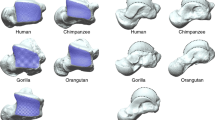Abstract
By using a new technique for determining relative metatarsal robusticity, the distribution of the 1+5 pattern (in which M5 is the second most robust metatarsal after M1) and 1→5 pattern (in which M5 is the least robust of all metatarsals) was established in primates and a few other plantigrade mammals. The first pattern is associated with a terrestrial and the second with an arboreal substrate. Robusticity formulae are not connected with specific locomotor patterns, but a total robusticity quotient is associated with these patterns and substrate preference as well. Changes in substrate preference are accompanied by changes of total robusticity, an increased number of permutations and ultimately a change of the robusticity pattern. Intermetatarsal robusticity gradients are related to the direction and intensity of muscular activity. A combined analysis of all factors can reveal a great deal of the locomotor history of a taxon.
Similar content being viewed by others
References
Archibald, J. D., C. O. Lovejoy, &K. G. Heiple, 1972. Implications of relative robusticity in the Olduvai metatarsus.Amer. J. Phys. Anthrop. 37: 93–95.
Baker, R. H., 1968. Habitats and distribution. In:Biology of Peromyscus (Rodentia),J. A. King (ed.), Amer. Soc. Mammalog., Special Publ. No. 2.
Campbell, B., 1966.Human Evolution: An Introduction to Man's Adaptations. Cambridge Univ. Press, New York.
Cartmill, M., 1972. Arboreal adaptations and the origin of the Order Primates. In:The Functional and Evolutionary Biology of Primates R. Tuttle (ed.), Aldine-Atherton, Chicago, New York, pp. 97–122.
Day, M. H. &J. R. Napier, 1964. Fossil footbones.Nature 201: 969–970.
Dice, L. R., 1922. Some factors affecting the distribution of the prairie vole, forest deer mouse, and prairie deer mouse.Ecology 3: 29–47.
Evans, F. C., 1957. Utilization of resources by experimental populations ofPeromyscus.Bull. Ecol. Soc. Amer. 38: 66 (abstract).
Findley, J. S., 1967. Insectivores and Dermopterans. In:Recent Mammals of the World S. Anderson &J. Knox Jones, Jr., (eds.), The Ronald Press Co., New York, pp. 87–108.
Foster, D. D., 1959. Differences in behavior and temperament between two races of deer mouse.J. Mamm. 40: 496–513.
Grassé, P. P., 1955.Traité de Zoologie. Masson et Cie, Paris.
Hershkovitz, P., 1962. Evolution of neotropical cricetine Rodents (Muridae).Fieldiana: Zoology, 46.
Horner, B. E., 1954. Arboreal adaptations ofPeromyscus with special reference to the use of the tail.Contr. Lab. Vert. Biol., Univ. Mich. 61: 1–85.
King, J. A., 1968. Psychology. In:Biology of Peromyscus (Rodentia),J. A. King (ed.), The Amer. Soc. of Mamm., Special Publ. No. 2.
——, 1968. Behavioral comparisons within the genusPeromyscus.Papers Mich. Acad. Sci., Arts & Letters 53: 113–136.
——, 1964. Sand digging contingent upon bar-pressing in deer mice (Peromyscus).Anim. Behav. 12: 446–450.
Napier, J. R. &P. H. Napier, 1967.A Handbook of Living Primates Academic Press, London.
——, 1967. Vertical clinging and leaping: a newly recognized category of locomotor behavior among primates.Folia primat. 6: 180–203.
Riesenfeld, A., 1972. Metatarsal robusticity in bipedal rats.Amer. J. Phys. Anthrop. 36: 229–233.
——, 1974. Changes in metatarsal robusticity following experimental surgery.Amer. J. Phys. Anthrop., 40: 205–212.
Simons, E. L., 1962. Fossil evidence relating to the early evolution of primate behavior.Ann. N. Y. Acad. Sci. 102: 282–294.
——, 1972.Primate Evolution, An Introduction to Man's Place in Nature Macmillan Co., New York.
Sussman, R. W., An ecological study of two Madagascar primates:Lemur fulvus rufus andLemur catta. Ph. D. thesis, Duke Univ. (in prep.).
Szalay, F. S., 1972. Paleobiology of the earliest primates. In:The Functional and Evolutionary Biology of Primates R. Tuttle (ed.), Aldine-Atherton, Chicago, New York, pp. 3–35.
——, 1974. Origins, evolution, and function of the tarsus in late Cretaceous eutherians and Paleocene primates. In:Advances in Primatology: Primate Locomotion,Jenkins,F. A.,Jr. (ed.), Academic Press, N. Y., pp. 223–259.
Taylor, J. R. &H. McCarley, 1963. Vertical distribution ofPeromyscus leucopus andP. gossipinus under experimental conditions.Southwest Nat. 8: 107–108.
Verts, B. J., 1957. The population and distribution of two species ofPeromyscus on some Illinois strip-mined land.J. Mamm. 38: 53–59.
Walker, E. P., 1964.Mammals of the World, 2 vols. The Johns Hopkins Press, Baltimore.
Author information
Authors and Affiliations
Additional information
Also ofThe Institute of Applied Biology, New York.
About this article
Cite this article
Riesenfeld, A. Metatarsal robusticity in primates and a few other plantigrade mammals. Primates 15, 1–25 (1974). https://doi.org/10.1007/BF01749589
Received:
Accepted:
Issue Date:
DOI: https://doi.org/10.1007/BF01749589




